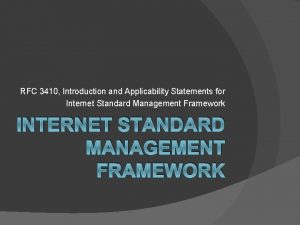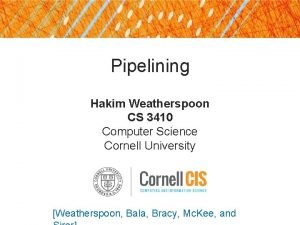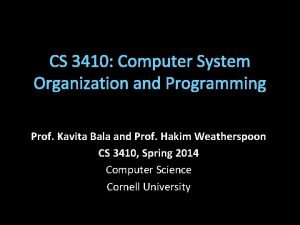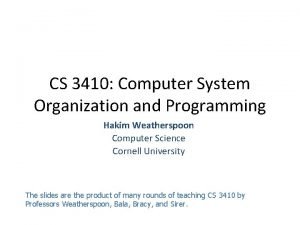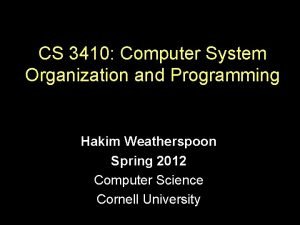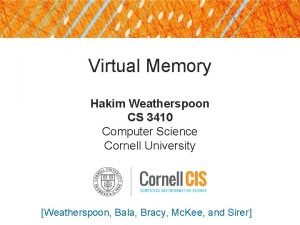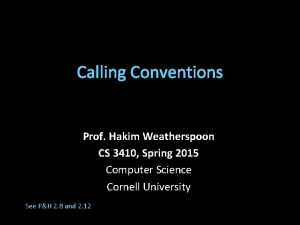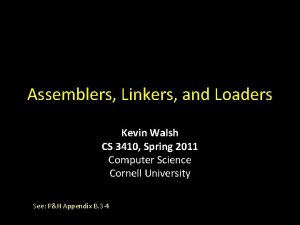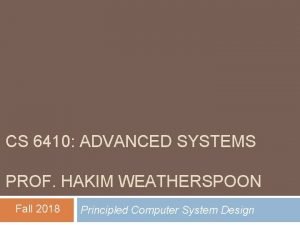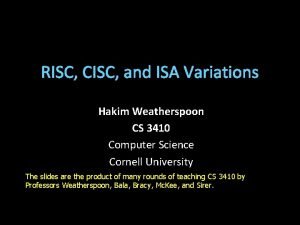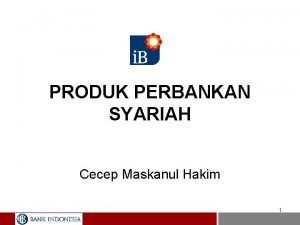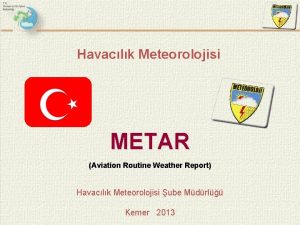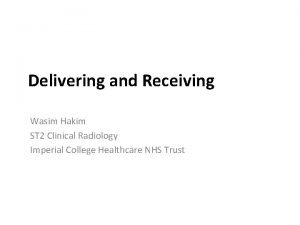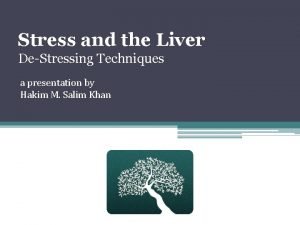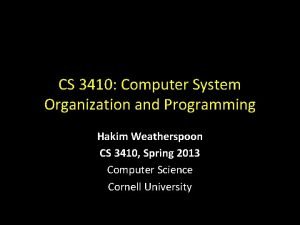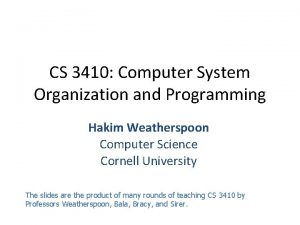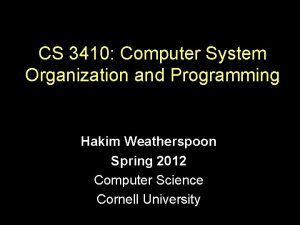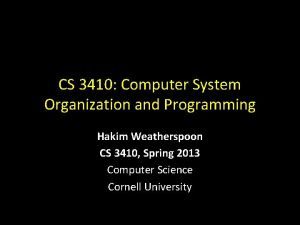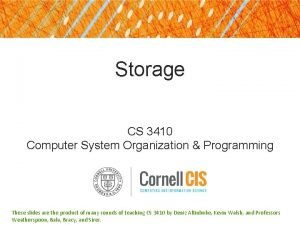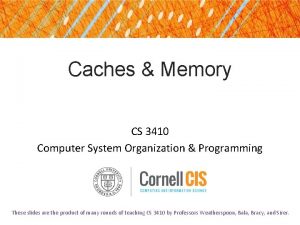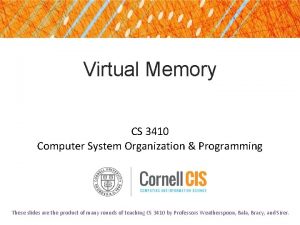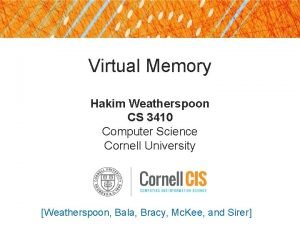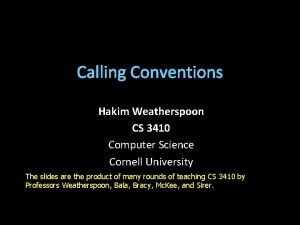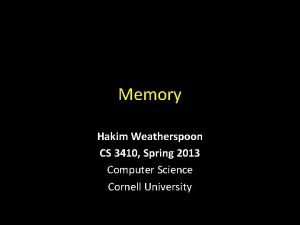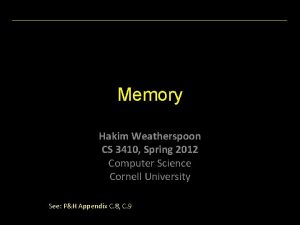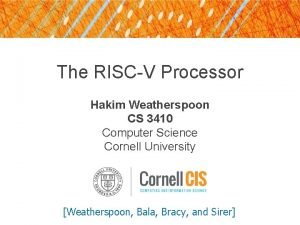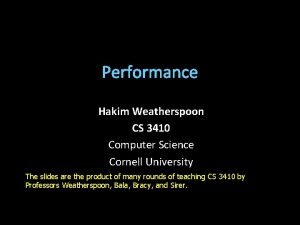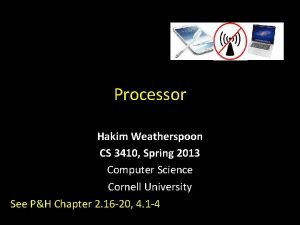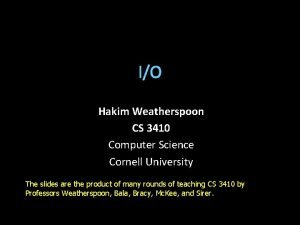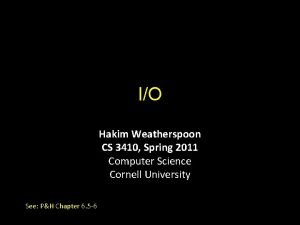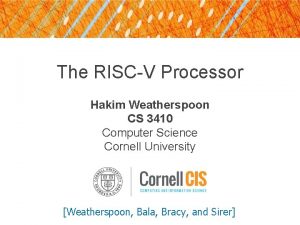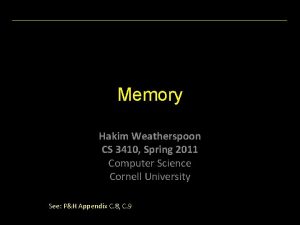CS 3410 Computer System Organization and Programming Hakim

























- Slides: 25

CS 3410: Computer System Organization and Programming Hakim Weatherspoon Computer Science Cornell University The slides are the product of many rounds of teaching CS 3410 by Professors Weatherspoon, Bala, Bracy, and Sirer.

The Analytical Engine • Designed by Charles Babbage from 1834 – 1871 • Considered to be the first digital computer • Built from mechanical gears, where each gear represented a discrete value (0 -9) • Babbage died before it was finished http: //history-computer. com http: //wikimedia. com 2

Turing Machine 1936 Alan Turing = abstract model for CPU that can simulate any algorithm 3

The Bombe Enigma machine Used by the Germans during World War II to encrypt and exchange secret messages used by the Allies to break the German Enigma machine during World War II 4

ENIAC Electronic Numerical Integrator And Computer 1946 John Mauchly J. Presper Eckert 5

IBM 7090 Human Computers programming the IBM 7090 Mary Jackson Hidden Figures 6

Who are you? “Sometimes it is the people that no one imagines anything of who do the things that no one can imagine. ” – Alan Turing • Turing Award Winners? • Eckert Mauchly Award Winners? 7

Course Objective • Understand the HW / SW interface software How a processor works § How a computer is organized § • Establish a foundation for building applications How to write a good program • Good = correct, fast, and secure § How to understand where the world is going § • Understand technology (past, present, future) 8

What is this? #include <stdio. h> int main() { printf("Hello world!n"); return 0; } How does it work? I’m glad you asked… 15 weeks later and you’ll know! “I know Kung Fu. ” 9

Compilers & Assemblers C int x = 10; x = 2 * x + 15; r 0 = 0 compiler MIPS assembly language addi r 5, r 0, 10 muli r 5, 2 addi r 5, 15 r 5 = r 0 + 10 r 5 = r 5 * 2 r 5 = r 5 + 15 assembler MIPS machine language op = addi r 0 r 5 10 001000001010000001010 000000010100001000000 001000001010000001111 op = addi r 5 15 10 Everything is a number!

How to Design a Simple Processor 0 inst memory 32 2 32 pc register file r 5 r 0 5 5 5 00 new pc calculation alu 10 10 control 00: addi 04: muli 08: addi r 5, r 0, 10 r 5, 2 r 5, 15 11

Instruction Set Architecture (ISA) • abstract interface between hardware and the lowest level software • user portion of the instruction set plus the operating system interfaces used by application programmers 12

Basic Computer System • A processor executes instructions § Processor has some internal state in storage elements (registers) • A memory holds instructions and data § von Neumann architecture: combined inst and data • A bus connects the two regs processor 01010000 10010100 … bus addr, data, r/w memory

Overview Application Operating System Compiler Memory system Firmware Instr. Set Proc. Instruction Set Architecture I/O system Datapath & Control Digital Design Circuit Design 14

Covered in this course Application Operating System Compiler Memory system Firmware CPU Instruction Set Architecture I/O system Datapath & Control Digital Design Circuit Design 15

Where did it begin? • Electrical Switch On/Off § Binary § • Transistor The first transistor on a workbench at AT&T Bell Labs in 1947 Transistors 16

• 1965 § Moore’s Law # of transistors integrated on a die doubles every 18 -24 months (i. e. , grows exponentially with time) • Amazingly visionary § § § § 2300 transistors, 1 MHz clock (Intel 4004) - 1971 16 Million transistors (Ultra Sparc III) 42 Million transistors, 2 GHz clock (Intel Xeon) – 2001 55 Million transistors, 3 GHz, 130 nm technology, 250 mm 2 die (Intel Pentium 4) – 2004 290+ Million transistors, 3 GHz (Intel Core 2 Duo) – 2007 721 Million transistors, 2 GHz (Nehalem) - 2009 1. 4 Billion transistors, 3. 4 GHz Intel Haswell (Quad core) – 2013 7. 2 Billion transistors, 3 -3. 9 GHz Intel Broadwell (22 -core) – 2016 17

18

Processor Performance Increase Intel Pentium 4/3000 Intel Xeon/2000 DEC Alpha 21264 A/667 DEC Alpha 5/500 DEC Alpha 21264/600 DEC Alpha 5/300 DEC Alpha 4/266 IBM POWER 100 DEC AXP/500 HP 9000/750 IBM RS 6000 MIPS M 2000 SUN-4/260 MIPS M/120 19

Then and Now http: //techguru 3 d. com/4 th-gen-intel-haswell-processors-architecture-and-lineup/ • The first transistor • Intel Haswell • One workbench at AT&T Bell Labs • 1947 • Bardeen, Brattain, and Shockley • • • 1. 4 billion transistors, 22 nm 177 square millimeters Four processing cores What are we doing with all these transistors? https: //en. wikipedia. org/wiki/Transistor_count 20

Then and Now https: //www. computershopper. com/computex-2015/performance-preview-desktop-broadwell-at-computex-2015 • The first transistor • Intel Broadwell • One workbench at AT&T Bell Labs • 1947 • Bardeen, Brattain, and Shockley • • • 7. 2 billion transistors, 14 nm 456 square millimeters Up to 22 processing cores What are we doing with all these transistors? https: //en. wikipedia. org/wiki/Transistor_count 21

Then and Now • The first transistor • Galaxy Note 8 • One workbench at AT&T Bell Labs • 1947 • Bardeen, Brattain, and Shockley • • 8 processing cores Exynos 9 Octa 8895 processor What are we doing with all these transistors? https: //en. wikipedia. org/wiki/Exynos

What are we doing with all these transistors? • Everything these days! § Phones, cars, televisions, games, computers, …

Computer System Organization 24

Reflect Why take this course? Basic knowledge needed for all other areas of CS: operating systems, compilers, . . . Levels are not independent hardware design ↔ software design ↔ performance Crossing boundaries is hard but important device drivers Good design techniques abstraction, layering, pipelining, parallel vs. serial, . . . Understand where the world is going The Mysteries of Computing will be revealed! 25
 Concept of nano programming
Concept of nano programming Process organization in computer organization
Process organization in computer organization Computer architecture vs organization
Computer architecture vs organization Runtime programming
Runtime programming Rfc3410
Rfc3410 Cornell cs 3410
Cornell cs 3410 Cornell cs 3410
Cornell cs 3410 Cs 3410
Cs 3410 Cs 3410
Cs 3410 Cs 3410
Cs 3410 Cs 3410
Cs 3410 Cs 3410
Cs 3410 Basic structure of a computer
Basic structure of a computer Interrupt cycle flow chart
Interrupt cycle flow chart Basic computer design
Basic computer design Kuva-yi milliye'yi amil ve milli iradeyi hakim kılma
Kuva-yi milliye'yi amil ve milli iradeyi hakim kılma Hakim weatherspoon
Hakim weatherspoon Dedi budiman hakim
Dedi budiman hakim Hakim isa
Hakim isa Cecep maskanul hakim
Cecep maskanul hakim Reshra ne demek
Reshra ne demek Wasim hakim
Wasim hakim Hakim salim khan
Hakim salim khan Wasyawirhum fil amri
Wasyawirhum fil amri Hakim abdul hameed
Hakim abdul hameed Eropa kontinental
Eropa kontinental




